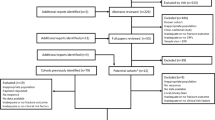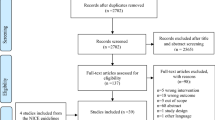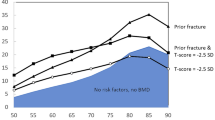Abstract
Summary
We systematically reviewed the literature on the performance of osteoporosis absolute fracture risk assessment instruments. Relatively few studies have evaluated the calibration of instruments in populations separate from their development cohorts, and findings are mixed. Many studies had methodological limitations making susceptibility to bias a concern.
Introduction
The aim of this study was to systematically review the literature on the performance of osteoporosis clinical fracture risk assessment instruments for predicting absolute fracture risk, or calibration, in populations other than their derivation cohorts.
Methods
We performed a systematic review, and MEDLINE, Embase, Cochrane Library, and multiple other literature sources were searched. Inclusion and exclusion criteria were applied and data extracted, including information about study participants, study design, potential sources of bias, and predicted and observed fracture probabilities.
Results
A total of 19,949 unique records were identified for review. Fourteen studies met inclusion criteria. There was substantial heterogeneity among included studies. Six studies assessed the WHO’s Fracture Risk Assessment (FRAX) instrument in five separate cohorts, and a variety of risk assessment instruments were evaluated in the remainder of the studies. Approximately half found good instrument calibration, with observed fracture probabilities being close to predicted probabilities for different risk categories. Studies that assessed the calibration of FRAX found mixed performance in different populations. A similar proportion of studies that evaluated simple risk assessment instruments (≤5 variables) found good calibration when compared with studies that assessed complex instruments (>5 variables). Many studies had methodological features making them susceptible to bias.
Conclusions
Few studies have evaluated the performance or calibration of osteoporosis fracture risk assessment instruments in populations separate from their development cohorts. Findings are mixed, and many studies had methodological limitations making susceptibility to bias a possibility, raising concerns about use of these tools outside of the original derivation cohorts. Further studies are needed to assess the calibration of instruments in different populations prior to widespread use.

Similar content being viewed by others
References
Lin JT, Lane JM (2004) Osteoporosis: a review. Clin Orthop Relat Res 126–134
Burge R, Dawson-Hughes B, Solomon DH, Wong JB, King A, Tosteson A (2007) Incidence and economic burden of osteoporosis-related fractures in the United States, 2005–2025. J Bone Miner Res 22:465–475
MacDermid JC, Roth JH, Richards RS (2003) Pain and disability reported in the year following a distal radius fracture: a cohort study. BMC Musculoskelet Disord 4:24
U.S. Department of Health and Human Services (2004) Bone health and osteoporosis: a report of the Surgeon General. U.S. Department of Health and Human Services, Office of the Surgeon General, Rockville
Stafford RS, Drieling RL, Hersh AL (2004) National trends in osteoporosis visits and osteoporosis treatment, 1988–2003. Arch Intern Med 164:1525–1530
Nguyen TV, Center JR, Eisman JA (2004) Osteoporosis: underrated, underdiagnosed and undertreated. Med J Aust 180:S18–S22
Vestergaard P, Rejnmark L, Mosekilde L (2005) Osteoporosis is markedly underdiagnosed: a nationwide study from Denmark. Osteoporos Int 16:134–141
Leslie WD, Schousboe JT (2011) A review of osteoporosis diagnosis and treatment options in new and recently updated guidelines on case finding around the world. Curr Osteoporos Rep 9:129–140
van Staa TP, Geusens P, Kanis JA, Leufkens HG, Gehlbach S, Cooper C (2006) A simple clinical score for estimating the long-term risk of fracture in post-menopausal women. QJM 99:673–682
Leslie WD, Berger C, Langsetmo L, Lix LM, Adachi JD, Hanley DA, Ioannidis G, Josse RG, Kovacs CS, Towheed T, Kaiser S, Olszynski WP, Prior JC, Jamal S, Kreiger N, Goltzman D (2011) Construction and validation of a simplified fracture risk assessment tool for Canadian women and men: results from the CaMos and Manitoba cohorts. Osteoporos Int 22:1873–1883
Bolland MJ, Siu AT, Mason BH, Horne AM, Ames RW, Grey AB, Gamble GD, Reid IR (2011) Evaluation of the FRAX and Garvan fracture risk calculators in older women. J Bone Miner Res 26:420–427
Tamaki J, Iki M, Kadowaki E, Sato Y, Kajita E, Kagamimori S, Kagawa Y, Yoneshima H (2011) Fracture risk prediction using FRAX(R): a 10-year follow-up survey of the Japanese Population-Based Osteoporosis (JPOS) Cohort Study. Osteoporos Int 22:3037–3045
Lo JC, Pressman AR, Chandra M, Ettinger B (2011) Fracture risk tool validation in an integrated healthcare delivery system. Am J Manag Care 17:188–194
Leslie WD, Lix LM, Johansson H, Oden A, McCloskey E, Kanis JA (2010) Independent clinical validation of a Canadian FRAX tool: fracture prediction and model calibration. J Bone Miner Res 25:2350–2358
Langsetmo L, Nguyen TV, Nguyen ND, Kovacs CS, Prior JC, Center JR, Morin S, Josse RG, Adachi JD, Hanley DA, Eisman JA (2011) Independent external validation of nomograms for predicting risk of low-trauma fracture and hip fracture. CMAJ 183:E107–114
Hippisley-Cox J, Coupland C (2009) Predicting risk of osteoporotic fracture in men and women in England and Wales: prospective derivation and validation of QFractureScores. BMJ 339:b4229
Ettinger B, Hillier TA, Pressman A, Che M, Hanley DA (2005) Simple computer model for calculating and reporting 5-year osteoporotic fracture risk in postmenopausal women. J Womens Health (Larchmt) 14:159–171
Leslie WD, Lix LM (2010) Simplified 10-year absolute fracture risk assessment: a comparison of men and women. J Clin Densitom 13:141–146
Abrahamsen B, Vestergaard P, Rud B, Barenholdt O, Jensen JE, Nielsen SP, Mosekilde L, Brixen K (2006) Ten-year absolute risk of osteoporotic fractures according to BMD T score at menopause: the Danish Osteoporosis Prevention Study. J Bone Miner Res 21:796–800
Leslie WD, Tsang JF, Lix LM (2008) Validation of ten-year fracture risk prediction: a clinical cohort study from the Manitoba Bone Density Program. Bone 43:667–671
Collins GS, Mallett S, Altman DG (2011) Predicting risk of osteoporotic and hip fracture in the United Kingdom: prospective independent and external validation of QFractureScores. BMJ 342:d3651
Czerwinski E, Kanis JA, Osieleniec J, Kumorek A, Milert A, Johansson H, McCloskey EV, Gorkiewicz M (2011) Evaluation of FRAX to characterise fracture risk in Poland. Osteoporos Int 22:2507–2512
Ahmed LA, Schirmer H, Fønnebø V, Joakimsen RM, Berntsen GK (2006) Validation of the Cummings' risk score; How well does it identify women with high risk of hip fracture: The Tromsø Study. Eur J Epidemiol 21(11):815–822
Azagra R, Roca G, Encabo G, Prieto D, Aguye A, Zwart M, Guell S, Puchol N, Gene E, Casado E, Sancho P, Sola S, Toran P, Iglesias M, Sabate V, Lopez-Exposito F, Ortiz S, Fernandez Y, Diez-Perez A (2011) Prediction of absolute risk of fragility fracture at 10 years in a Spanish population: validation of the WHO FRAX TM tool in Spain. BMC Musculoskelet Disord 12:30
Body JJ, Moreau M, Bergmann P, Paesmans M, Dekelver C, Lemaire ML (2008) Absolute risk fracture prediction by risk factors validation and survey of osteoporosis in a Brussels cohort followed during 10 years (FRISBEE study). Rev Med Brux 29(4):289–293
Cheung, EYN, Bow CH, Cheung CL, Soong C, Yeung S, Loong C, Kung A (2012) Discriminative value of FRAX for fracture prediction in a cohort of Chinese postmenopausal women. Osteoporos Int 23: 871–878
Colon-Emeric CS, Pieper CF, Artz MB (2002) Can historical and functional risk factors be used to predict fractures in community-dwelling older adults? Development and validation of a clinical tool. Osteoporos Int 13(12):955–961
De Laet CE, Van Hout BA, Burger H, Weel AE, Hofman A, Pols HA (1998) Hip fracture prediction in elderly men and women: validation in the Rotterdam study. J Bone Miner Res 13(10):1587–1593
Durosier C, Hans D, Krieg MA, Schott AM (2008) Defining risk thresholds for a 10-year probability of hip fracture model that combines clinical risk factors and quantitative ultrasound: results using the EPISEM cohort. J Clin Densitom 11(3):397–403
Ensrud KE, Lu LY, Taylor BC, Schousboe JT, Donaldson MG, Fink HA, Cauley JA, Hillier TA, Browner WS, Cummings SR, Study of Osteoporotic Fractures Research, Group (2009) A comparison of prediction models for fractures in older women: is more better? Arch Intern Med 169(22):2087–2094
Fujiwara S, Hamaya E, Goto W, Masunari N, Furukawa K, Fukunaga M, Nakamura T, Miyauchi A, Chen P (2011) Vertebral fracture status and the World Health Organization risk factors for predicting osteoporotic fracture risk in Japan. Bone 49:520–525
Girman CJ, Chandler JM, Zimmerman SI, Martin AR, Hawkes W, Hebel JR, Sloane PD, Magaziner J (2002) Prediction of fracture in nursing home residents. J Am Geriatr Soc 50(8):1341–1347
Hans D, Durosier C, Kanis JA, Johansson H, Schott-Pethelaz A-M, Krieg M-A (2008) Assessment of the 10-year probability of osteoporotic hip fracture combining clinical risk factors and heel bone ultrasound: the EPISEM prospective cohort of 12,958 elderly women. J Bone Miner Res 23(7):1045–1051
Hundrup YA, Jacobsen RK, Andreasen AH, Davidsen M, Obel EB, Abrahamsen B (2010) Validation of a 5-year risk score of hip fracture in postmenopausal women. The Danish Nurse Cohort Study. Osteoporos Int 21(12):2135–2142
Kanis JA, Oden A, Johnell O, Johansson H, De Laet C, Brown J, Burckhardt P, Cooper C, Christiansen C, Cummings S, Eisman JA, Fujiwara S, Gluer C, Goltzman D, Hans D, Krieg M-A, La Croix A, McCloskey E, Mellstrom D, Melton LJ 3rd, Pols H, Reeve J, Sanders K, Schott A-M, Silman A, Torgerson D, van Staa T, Watts NB, Yoshimura N (2007) The use of clinical risk factors enhances the performance of BMD in the prediction of hip and osteoporotic fractures in men and women. Osteoporos Int 18(8):1033–1046
Leslie WD, Tsang JF, Lix LM, Manitoba Bone Density Program (2009) Simplified system for absolute fracture risk assessment: clinical validation in Canadian women. J Bone Miner Res 24(2):353–360
Melton LJ 3rd, Atkinson EJ, Khosla S, Oberg AL, Riggs BL (2005) Evaluation of a prediction model for long-term fracture risk. J Bone Miner Res 20(4):551–556
Moayyeri A, Welch A, Luben RN, Wareham NJ, Bingham S, Khaw KT (2007) Height loss predicts fractures in middle aged and older men and women: European prospective investigation into cancer-Norfolk population cohort study. J Bone Miner Res 22(Suppl 1):S79
Nguyen ND, Frost SA, Center JR, Eisman JA, Nguyen TV (2007) Development of a clinical nomogram for individualizing 5-year and 10-year risks of fracture. Bone (New York) 40(6, Suppl 2):S148–S149
Sandhu SK, Nguyen ND, Center JR, Pocock NA, Eisman JA, Nguyen TV (2010) Prognosis of fracture: evaluation of predictive accuracy of the FRAX™ algorithm and Garvan nomogram. Osteoporos Int 21(5):863–871
Sanfelix-Genoves J, Peiro S, Sanfelix-Gimeno G, Giner V, Gil V, Pascual M, Fluixa C, Fuertes A, Hurtado I, Ferreros I (2010) Development and validation of a population-based prediction scale for osteoporotic fracture in the region of Valencia, Spain: the ESOSVAL-R study. BMC Public Health 10:153
Sornay-Rendu E, Munoz F, Delmas PD, Chapurlat RD (2010) The FRAX tool in French women: how well does it describe the real incidence of fracture in the OFELY cohort? J Bone Miner Res 25(10):2101–2107
Tanaka S, Yoshimura N, Kuroda T, Hosoi T, Saito M, Shiraki M (2010) The Fracture and Immobilization Score (FRISC) for risk assessment of osteoporotic fracture and immobilization in postmenopausal women—a joint analysis of the Nagano, Miyama, and Taiji Cohorts. Bone 47(6):1064–1070
Tremollieres FA, Pouilles J-M, Drewniak N, Laparra J, Ribot CA, Dargent-Molina P (2010) Fracture risk prediction using BMD and clinical risk factors in early postmenopausal women: sensitivity of the WHO FRAX tool. J Bone Miner Res 25(5):1002–1009
Van Geel T, Geusens P, Dinant G-J, Huntjens K, Bours S, van den Bergh J (2011) Comparing FRAX and Garvan Fracture Risk Calculator in postmenopausal women: a prospective 5-year follow-up study. Bone 48:S63
Van Staa T-P, Geusens P, Pols HAP, de Laet C, Leufkens HGM, Cooper C (2005) A simple score for estimating the long-term risk of fracture in patients using oral glucocorticoids. QJM 98(3):191–198
Kanis JA, Oden A, Johansson H, McCloskey E (2012) Pitfalls in the external validation of FRAX. Osteoporos Int 23:423–431
Steurer J, Haller C, Hauselmann H, Brunner F, Bachmann LM (2011) Clinical value of prognostic instruments to identify patients with an increased risk for osteoporotic fractures: systematic review. PLoS One 6:e19994
Nelson HD, Haney EM, Dana T, Bougatsos C, Chou R (2010) Screening for osteoporosis: an update for the U.S. Preventive Services Task Force. Ann Intern Med 153:99–111
Cook NR (2008) Statistical evaluation of prognostic versus diagnostic models: beyond the ROC curve. Clin Chem 54:17–23
Ensrud KE, Lui LY, Taylor BC, Schousboe JT, Donaldson MG, Fink HA, Cauley JA, Hillier TA, Browner WS, Cummings SR (2009) A comparison of prediction models for fractures in older women: is more better? Arch Intern Med 169:2087–2094
Cooper C, Cole ZA, Holroyd CR, Earl SC, Harvey NC, Dennison EM, Melton LJ, Cummings SR, Kanis JA (2011) Secular trends in the incidence of hip and other osteoporotic fractures. Osteoporos Int 22:1277–1288
Leslie WD, Sadatsafavi M, Lix LM, Azimaee M, Morin S, Metge CJ, Caetano P (2011) Secular decreases in fracture rates 1986–2006 for Manitoba, Canada: a population-based analysis. Osteoporos Int 22:2137–2143
Adams AL, Shi J, Takayanagi M, Dell RM, Funahashi TT, Jacobsen SJ (2013) Ten-year hip fracture incidence rate trends in a large California population, 1997–2006. Osteoporos Int 24:373–376
Acknowledgments
The authors thank the following individuals who kindly provided requested data from their papers: MJ Bolland, GS Collins, E Czerwinski, B Ettinger, DA Hanley, A Kumorek, WD Leslie, L Langsetmo, and J Tamaki.
Sources of funding
Smita Nayak was supported by grant 7R01AR060809-03 from the National Institute of Arthritis and Musculoskeletal and Skin Diseases; Susan L. Greenspan was supported by NIH grants P30AG024827 and R01AG028068-01A2.
Conflicts of interest
None.
Author information
Authors and Affiliations
Corresponding author
Electronic supplementary material
Below is the link to the electronic supplementary material.
Supplementary material Table 1
(DOCX 94.1 KB)
Rights and permissions
About this article
Cite this article
Nayak, S., Edwards, D.L., Saleh, A.A. et al. Performance of risk assessment instruments for predicting osteoporotic fracture risk: a systematic review. Osteoporos Int 25, 23–49 (2014). https://doi.org/10.1007/s00198-013-2504-5
Received:
Accepted:
Published:
Issue Date:
DOI: https://doi.org/10.1007/s00198-013-2504-5




